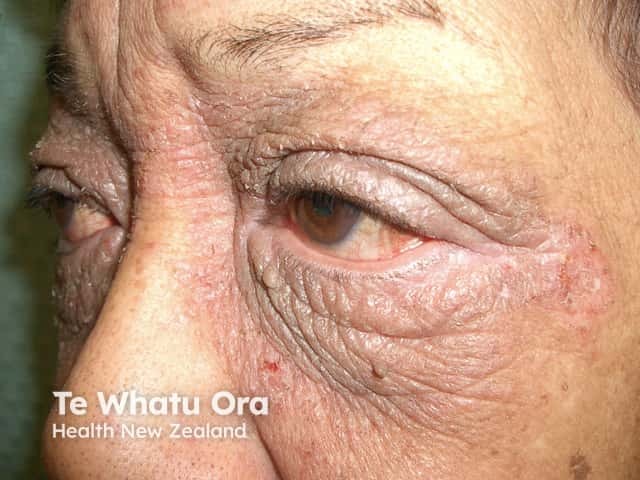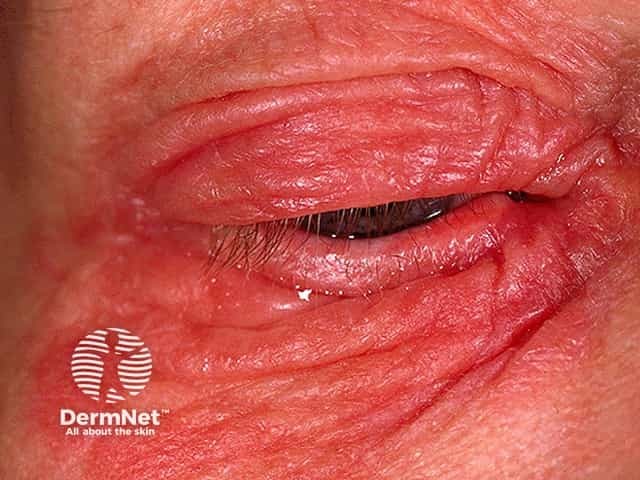Main menu
Common skin conditions

NEWS
Join DermNet PRO
Read more
Quick links
Eyelid contact dermatitis — extra information
Eyelid contact dermatitis
Author: Dr Emily Ryder, Dermatology Registrar, Addenbrooke's Hospital, Cambridge, United Kingdom; Chief Editor: Dr Amanda Oakley, Dermatologist, Hamilton, New Zealand; Copy Editor, Clare Morrison, May 2014.
Introduction
Irritant eyelid contact dermatitis
Allergic eyelid contact dermatitis
Treatment
What is eyelid contact dermatitis?
Eyelid contact dermatitis is an inflammatory reaction involving the eyelid skin that is caused by contact with a trigger substance. It may be due to allergy (allergic contact dermatitis) or irritation (irritant contact dermatitis). Eyelid dermatitis is also called eyelid eczema.
Upper, lower or both eyelids on one or both sides can be affected by contact dermatitis. The patient may report itching, stinging or burning, and the lids are red and scaly. They may swell. With persistence of the dermatitis, the eyelids become thickened with increased skin markings (lichenification). The eyelid margins may become involved (blepharitis). The appearance is similar, whatever the cause.
The thin skin of the eyelids is particularly sensitive to irritants and allergens and is thus prone to develop contact dermatitis. Contact with the same trigger may not lead to a rash on other areas of skin.

Mild chronic eyelid dermatitis

Severe chronic eyelid dermatitis

Severe acute eyelid dermatitis
See more images of eyelid contact dermatitis.
Irritant eyelid contact dermatitis
How does irritant eyelid contact dermatitis occur?
Irritant contact dermatitis is an innate inflammatory reaction due to injury to the skin. Unlike allergic contact dermatitis, it does not involve specific antibodies (immunoglobulins) or specific immune cells (memory T cells).
What triggers irritant eyelid contact dermatitis?
Irritant contact dermatitis may be triggered by contact with irritating substances and/or physical triggers.
Irritating substances that may cause irritant contact dermatitis of the eyelids include:
- Soaps and detergents
- Acids and alkalis
- Chemicals such as chlorine under goggles worn when swimming
- Dust particles
- Hydrophobic substances (comprised of molecules that repel water, i.e. drying agents)
- Cosmetics such as eyeliner, eye shadow, mascara and sunscreen.
These substances may touch the eyelids directly or be transferred from the fingers (which may be unaffected by dermatitis).
Physical triggers that may cause irritant contact dermatitis include:
- Temperature extremes (heat or cold)
- Humidity extremes (dry or moist)
- Mechanical (rubbing or scratching).
Who gets irritant eyelid contact dermatitis?
Irritant eyelid contact dermatitis can occur in anyone. However, it is more common in people with sensitive skin. People with a background of atopic eczema, asthma and hayfever ('atopy') are more likely to suffer from irritant contact dermatitis than people without this history.
Any pre-existing inflammation of the skin can cause the skin's waterproof 'barrier' to be compromised and may make it more vulnerable to irritant contact dermatitis. Barrier function may also be defective for genetic reasons.
How is the diagnosis of irritant eyelid contact dermatitis made?
Diagnosis of eyelid irritant contact dermatitis is made by identifying its characteristic features:
- An itchy rash that affects one or both eyelids, which may occur intermittently or continuously
- Suspicion that it has been caused or aggravated by contact with an irritant (see list above)
- Often, pre-existing sensitive skin or atopic eczema
- Patch tests to suspected contact allergens are negative.
It may be difficult to identify the precise cause.
Allergic eyelid contact dermatitis
How does allergic eyelid contact dermatitis occur?
Allergic contact dermatitis is caused by an immune reaction to the trigger; this is known as the allergen. This is often a substance that the patient has been exposed to many times previously without problem. The rash usually occurs one to several days after the contact with the allergen. This can make it difficult to identify the cause of the dermatitis. Allergic contact dermatitis involves a delayed-type hypersensitivity reaction (also called type IV hypersensitivity) and involves immune memory cells.
What triggers allergic eyelid contact dermatitis?
Eyelid contact dermatitis follows direct contact with an allergen.
Allergy to cosmetics may be due to contact with allergens in:
- Emollients and moisturisers
- Eye creams
- Sunscreens
- Makeups
- Cleansers
- Fragrances and essential oils
- Jewellery containing nickel and gold.
Other potential allergens are found in:
- Eyelash curlers or tweezers (nickel)
- False eyelashes (components or more often, adhesives)
- Eye drops (preservatives and antiseptics)
- Contact lens solution
- Rubber goggles
- Spectacle frames.
Eyelid contact dermatitis may also occur following indirect contact with an allergen, due to transfer of small amounts of substance from the hands (through rubbing or touching the eyelids). Such allergens may include:
- Nickel from metal coins or clothes fastenings
- Fragrances
- Nail cosmetics (varnishes and false nails)
- Hair dye, ie paraphenylenediamine allergy.
Eyelid contact dermatitis is sometimes triggered by airborne allergens, such as dust mite and plant pollens. Compositae allergy is an example of an airborne allergen causing eyelid dermatitis.
Who gets allergic eyelid contact dermatitis?
Allergic eyelid contact dermatitis can occur in anyone. It is no more likely in those with known sensitive skin or atopic eczema than it is in people that have previously had no skin problem.
Contact allergy usually develops after repeated previous contact with the allergen, so it is not necessarily a new substance that has triggered the allergy.
How is the diagnosis of allergic eyelid contact dermatitis made?
Diagnosis of eyelid allergic contact dermatitis is made by identifying its characteristic features:
- An itchy rash that affects one or both eyelids
- This is most likely to occur intermittently at intervals of days to years
- Suspicion that it has been caused or aggravated by contact with an allergen (see list above)
- Patch tests to one or more suspected contact allergens are positive.
Knowing the details of all substances that the skin may have been exposed to in skin care, hobbies and work are an important part of the detective work required to find the cause of a eyelid dermatitis. Patch tests should be arranged to establish or confirm the triggering allergen.
What is the treatment for eyelid contact dermatitis?
It is important to avoid contact with irritants and known or potential allergens, to ensure that the skin is healthy and able to form a waterproof barrier.
- Avoid rubbing and scratching.
- Only touch eyelids with clean, rinsed hands.
- Wash eyelids with plain water or use a cream cleanser designed for sensitive skin.
- Avoid all contact with allergens detected by patch tests – this is necessary life-long.
- Avoid eyelid cosmetics while the dermatitis is active.
- Wear protective wrap-round spectacles if exposed to cold, wind, dust particles etc. Spectacles can also make it easier to stop scratching and rubbing the eyelids.
Short courses of mild topical corticosteroids (ie hydrocortisone 1% cream or ointment) or calcineurin inhibitors (ie pimecrolimus 1% cream) may be required to treat active inflammation. Severe contact dermatitis of the eyelids is usually treated with a short course of oral corticosteroids.
Eyelid dermatitis can be followed by postinflammatory pigmentation, one of the causes of dark circles under the eyes.
References
- Eds: Burns T, Breathnach, S, Cox N, Griffiths C. Rook’s Textbook of Dermatology: 8th Edition. 2010. Wiley-Blackwell. ISBN: 978-1-4051-6169-5
- Shah M, Lewis FM, Gawkrodger DJ. Facial dermatitis and eyelid dermatitis: a comparison of patch test results and final diagnoses. Contact Dermatitis 1996; 34: 140–1. PubMed
- Guin JD. Eyelid dermatitis: experience in 203 cases. J Am Acad Dermatol 2002; 47:755–65. PubMed
- Graves JE, Brodell RT. Erythematous scaling eyelids: patient history, exposure to allergens and irritants are keys to diagnosis. Postgrad Med 2005; 117: 43–5. PubMed
- Morris S, Barlow R, Selva D, Malhotra R. Allergic contact dermatitis: a case series and review for the ophthalmologist. Br J Ophthalmol. 2011; 95(7): 903–8 . PubMed
On DermNet
- Allergic conjunctivitis
- Dermatitis
- Contact dermatitis
- Atopic dermatitis
- Patch tests
- Blepharitis
- Dark circles under the eyes
